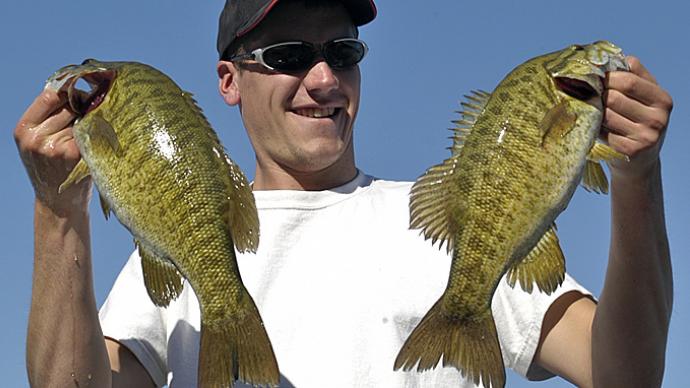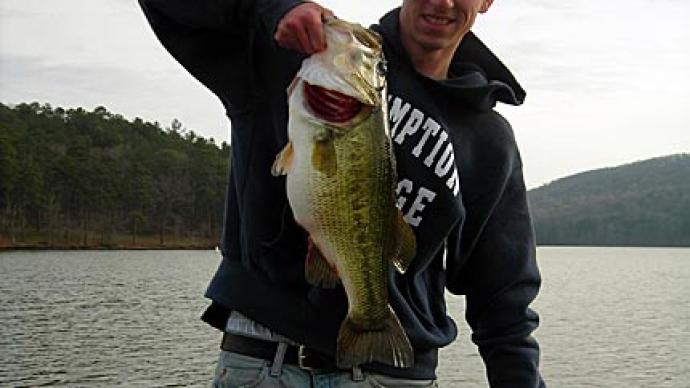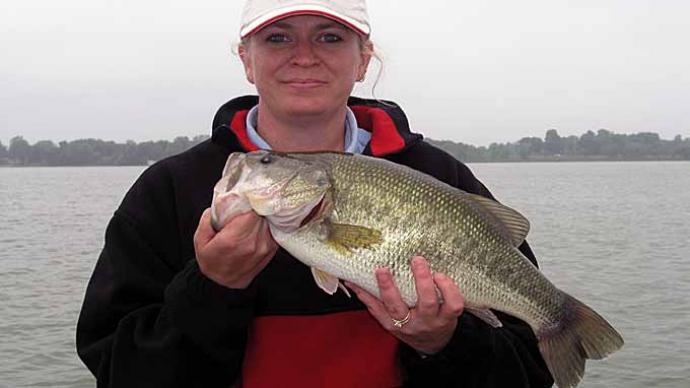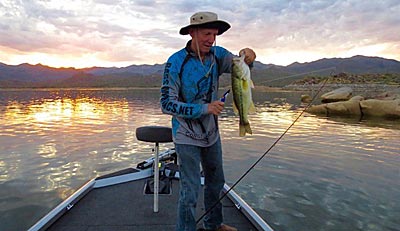
Pre-spawn bass can be notoriously fickle. This is partly due to the weather this time of year. It can wildly swing from cold to warm at the drop of a hat. Winter bass are still in the channel, which can mean the fish are 35 to 50 feet deep in a big reservoir. They’ll use a long point to start moving up, waiting for the water to warm up. There may be three or more waves of spawning bass, and when the water temperature reaches 58 or so, there may be some already on beds and some still waiting in deeper water.
A drop-shot rig can be fished down a channel inside a cove with good results, especially when the water is still cold and the fish haven’t moved up. One thing to remember is that different areas of the lake will warm up at different times, so you may find that in one cove, the fish are on beds, while in another, the water is still cold, and the fish are deep. Start working main and secondary points leading to spawning coves, working all the way out to the channel. A light drop-shot is critical, mainly when water is still cold. Fish won’t be as active, so tempt them with a snack. A 4-inch Roboworm on a split-shot rig is ideal. A straight tail will give it just enough movement. The more sluggish the fish are, the longer your leader should be.
Arizona pro Gary Senft rigs his drop-shot hooks on the line using bobber stoppers, making the leader adjustable. This also allows for easy re-rigging if the weight gets snagged and comes off. Gary likes to pitch finesse baits to the bank on steep bluffs or rip-rap this time of year, then experiment with the retrieve until he figures it out – do they want it bounced or just barely pulled? A variety of retrieves will help you zero in on what triggers the fish. Senft uses quite a bit of dye on his plastics, and if he’s using jigheads or bullet weights, he paints them with olive green or black spray paint.
Another ideal finesse bait for pre-spawn bass is a Senko. Even if you use a bigger one, a Senko is a finesse bait. Fish it unweighted, pitching to shore, especially shores with brush, and let it wiggle down to the bottom by itself. Once it hits bottom (your line will go slack), twitch it a bit to move it out deeper, then let it fall again. Be a line-watcher for the best results. If the fish are active, they’ll grab it and go, but if they are still deep and cold, they may just inhale it and hold on.
Finesse does not necessarily mean small baits – it’s more of a presentation. Arizona’s Johnny Johnson (host of the famous “Fishing with Johnny Johnson” television show) uses bigger baits that can be moved slowly but still cover plenty of water. He’ll take a spinnerbait and add some weight to it with Sticky Weights to get it down deep, and then he’ll crawl it slowly on the bottom, concentrating on spots near deep water, especially if he finds trees or other cover. He says a submerged tree in the right spot can hold a whole school of bass, so he’ll look for places like that in coves and washes.
Johnson says you don’t want to keep running during early spring once you catch a fish. “There can be acres of brush and stuff, but for a reason, all the fish will seem to be in one little patch,” he said.
His advice? If you catch one good fish, you must pay strict attention to where it is found. Then hang around and keep fishing that spot until you think they’re done biting. Even then, it’s worth coming back later in the day to see if they’re turned on again.
This time of year, the fish rarely slam a bait. Johnny says they’ll inhale it as it comes by, so it feels like someone cut your line. One second you’re feeling it thump away down there, and the next second – nothing. That’s your cue to set the hook.
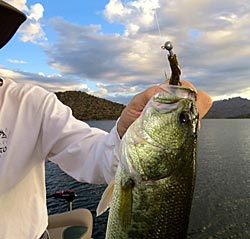
You may remember the Inchi Wacky technique introduced eight or so years ago from Japan, home of highly-pressured bass. Also called Flick Shaking, Takuma Hata and Toshiro Ono introduced this method. The Inchi Wacky is a wacky-rigged soft plastic on a tiny jighead. The jighead looks like you put a small split-shot on the hook, and that’s exactly what Arizona Bass Pro Shops pro Gary Senft does. He buys 90-degree bend hooks and a variety of split-shot weights from 1/32-1/8 ounce. Make sure to get the kind without ears. Alternatively, you can buy them from Jackall.
Like a Senko, the key to the Inchi Wacky is in the fall, which is unpredictable and even more erratic than a Senko. The Flick Shake worm has a bit of an s-curve built into it, which gives the rig a squirming action that is different from other techniques. Senft merely throws them out and lets them fall. Many bites come on the fall, and if it hits bottom, he lets it lie on a slightly slack line and simply shakes the rod tip.
Senft fishes these Inchi Wacky rigs anywhere from 1 to 30 feet deep and says that the shallower you’re fishing, the lighter the weight should be. He fishes it on an ultra-light spinning rod with a fast tip and uses 4-pound-test fluorocarbon line. The open hook makes for easy hook sets but also easy snags. Jackall makes Inchi Wacky hooks with weed guards, but even so, you’re going to get snagged once in a while. The bite can be a slight tic, a tug, or you may just see your line swim off. Senft says the bigger fish tend to just swim off with it. Just sweep and reel – the fine wire open hook will do the rest.
Shaky head fishing is just a finesse worm on a small dart head or pea head jig, something fishermen have been doing forever. Even a power fisherman like California pro Gary Dobyns knows that a small worm on a dart head is a limit finder when fishing gets tough.
“I’ve watched lots of guys throw small jigs,” Dobyns said. “They almost all make the same mistake. They cast it out, turn the reel handle, and watch the spot where the jig went into the water.” He says that doing this will make you miss your mark 100% of the time. Instead, cast the jig out and let the line free-spool off the reel until the lure hits bottom. While it’s falling, watch the line closely. Any subtle jump, bowing, or sideways movement usually means that a fish has gently inhaled your lure, and it’s a sign that you need to set the hook – fast! Dobyns says that the fish usually take the lure and turn, but sometimes they just swim right at you, so you must watch the line for movement.
If the jig hits the bottom without being eaten, Dobyns lifts and drags it across the bottom, starting quickly, then slowing down until he discovers the perfect speed that triggers bites. He also uses the trolling motor to drag the lure around on the bottom before reeling to re-cast. If the lure feels heavy when you lift the rod, set the hook by simply reeling and sweeping simultaneously. A fast reel will help you keep up with the fish.
Most of the time, you’ll downsize your lures when finesse fishing, but the most important thing is technique. The small size is more about a slow fall and subtle movement than simply a size reduction. Finesse is about tempting reluctant fish into biting by keeping an easy-to-catch, bite-sized meal right in front of his face. Slow down, keep your eyes on your line, and be patient.
BassResource may receive a portion of revenues if you make a purchase using a link above.


